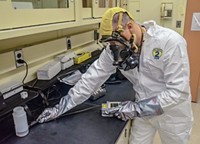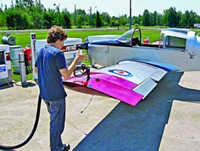Advertisement
Grab your lab coat. Let's get started
Welcome!
Welcome!
Create an account below to get 6 C&EN articles per month, receive newsletters and more - all free.
It seems this is your first time logging in online. Please enter the following information to continue.
As an ACS member you automatically get access to this site. All we need is few more details to create your reading experience.
Not you? Sign in with a different account.
Not you? Sign in with a different account.
ERROR 1
ERROR 1
ERROR 2
ERROR 2
ERROR 2
ERROR 2
ERROR 2
Password and Confirm password must match.
If you have an ACS member number, please enter it here so we can link this account to your membership. (optional)
ERROR 2
ACS values your privacy. By submitting your information, you are gaining access to C&EN and subscribing to our weekly newsletter. We use the information you provide to make your reading experience better, and we will never sell your data to third party members.
Environment
Mercury Is Out At NIST
Standards agency quits calibration of mercury thermometers
by David J. Hanson
March 7, 2011
| A version of this story appeared in
Volume 89, Issue 10

One of the original activities of the National Institute of Standards & Technology is now history. As of March 1, NIST no longer provides calibration services for mercury thermometers.
The move marks the end of an era; the organization had been performing this service since it opened as the National Bureau of Standards in 1901. NIST says that closing its program is part of a larger government effort—in collaboration with the Environmental Protection Agency, standards-setting organizations, and other groups—to phase out use of mercury thermometers altogether because of the element’s toxicity.
Eliminating the program “is something that has been in the works for five or six years,” says Gregory F. Strouse, the acting division chief of the Temperature, Pressure & Flow Metrology Division at NIST. “It’s the result of a number of things coming together, and we thought we could set a good example for other government agencies by stopping this service” of calibrating mercury thermometers.
One of the principal reasons for the move was the changing technology of thermometers. Strouse says that NIST used to do thousands of mercury calibrations each year. “We used to calibrate clinical mercury thermometers, and we did more than 10,000 per year,” he recalls. “This just sort of phased itself out as doctors stopped using mercury thermometers in their offices.” He says that NIST stopped calibrating clinical thermometers in the 1980s.
In the past, NIST also did 750 to 1,000 calibrations per year on industry thermometers, Strouse says, but the number has drastically dropped. Over the years, digital and electronic thermometers have replaced the older mercury instruments as prices of the new devices fell and their reliability rose. Last year the institute calibrated just four industry thermometers, Strouse tells C&EN.
Industry has had a hard time moving completely away from mercury thermometers. NIST continued to calibrate industrial thermometers because a number of industrial standards set by ASTM International, the international standards-setting organization, specifically prescribe use of a mercury thermometer. Of approximately 700 such standards, about 300 have been amended to allow use of mercury-free thermometers or digital thermometers. These standards are reviewed on a rolling basis, and NIST officials contend that all the mercury-specific standards will be revised in about three years.
“Last year we changed about 250 of the standards,” Strouse says. “We have done the easy ones and are down to dealing with the hard ones now.”
Some of the hard-to-change standards are in the petroleum industry, which is the last major industry sector still using mercury thermometers. “It’s a combination of two things—regulatory standards that they have to follow and the fact that they are just used to using mercury,” Strouse says.
One standard that’s making it hard for the petroleum industry to move away from mercury thermometers is the standard for flash point measurement. Strouse says NIST is going to industry facilities where flash points are measured and showing alternative thermometers that can be used to meet that standard.
For its part, the petroleum industry is working to make adjustments to a mercury-free environment. At the American Petroleum Institute, the trade association representing the oil industry, the change is under way. “An API task group with representatives from EPA and the industry is now developing a testing protocol for alternative devices with the objective of finding technology that is durable and accurate in field settings,” Bill Bush, an API spokesman, says.
The situation is different at scientific and research labs. “Most of the scientific fields switched over to digital or electronic thermometers a decade ago,” Strouse says, because in terms of accuracy, mercury thermometers “are at the bottom of the heap.” The most accurate device, he says, is the standard platinum resistance thermometer, which determines temperature by measuring the resistance changes in pure platinum.
Over the past three years, as it moved to eliminate calibration of mercury thermometers, NIST has recovered and recycled more than 8,000 mercury thermometers stored in its own cupboards and drawers. NIST reports it has sent the mercury from the thermometers to specialized recycling centers that repurpose the metal to produce compact fluorescent light bulbs.
“The amount of mercury in a compact fluorescent light bulb is about 1 to 4 mg,” says Strouse. Each recycled NIST thermometer contained about 500 mg of mercury, potentially providing the mercury for more than 125 bulbs.





Join the conversation
Contact the reporter
Submit a Letter to the Editor for publication
Engage with us on Twitter